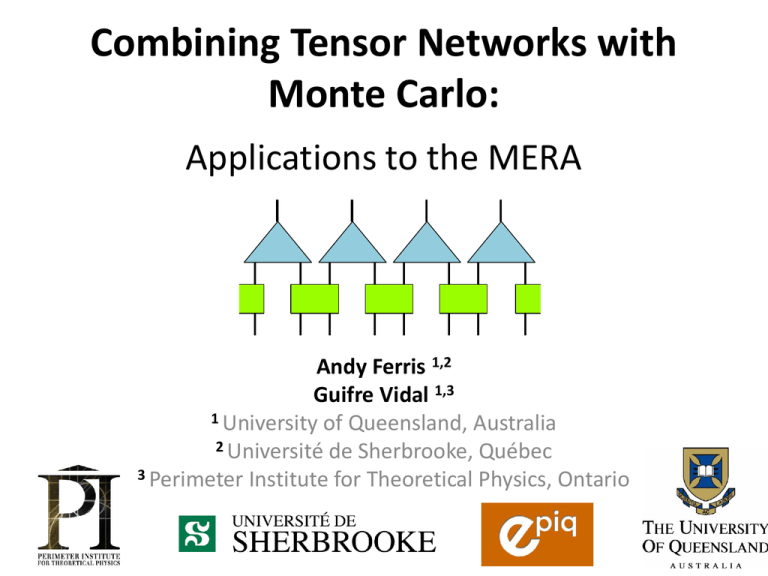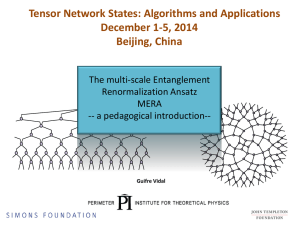Combining Tensor Networks with Monte Carlo: Applications to the
advertisement

Combining Tensor Networks with Monte Carlo: Applications to the MERA Andy Ferris 1,2 Guifre Vidal 1,3 1 University of Queensland, Australia 2 Université de Sherbrooke, Québec 3 Perimeter Institute for Theoretical Physics, Ontario Motivation: Make tensor networks faster χ ys s s s s s s 1 2 3 4 5 6 7 Parameters: dL vs. Poly(χ,d,L) Calculations should be efficient in memory and computation (polynomial in χ, etc) However total cost might still be HUGE (e.g. 2D) Monte Carlo makes stuff faster • Monte Carlo: Random sampling of a sum – Tensor contraction is just a sum • Variational MC: optimizing parameters • Statistical noise! 1 Error µ N – Reduced by importance sampling over some positive probability distribution P(s) æ E(s) ö E = å E(s) = å P(s). ç ÷ è P(s) ø s s Monte Carlo with Tensor networks Monte Carlo with Tensor networks E = å E(s) s æ E(s) ö E = å P(s). ç ÷ è P(s) ø s P(s) = Y s 2 Var[E(s) / P(s)] < Var[E(s)] Monte Carlo with Tensor networks MPS: Sandvik and Vidal, Phys. Rev. Lett. 99, 220602 (2007). CPS: Schuch, Wolf, Verstraete, and Cirac, Phys. Rev. Lett. 100, 040501 (2008). Neuscamman, Umrigar, Garnet Chan, arXiv:1108.0900 (2011), etc… PEPS: Wang, Pižorn, Verstraete, Phys. Rev. B 83, 134421 (2011). (no variational) … s E = å E(s) æ E(s) ö E = å P(s). ç ÷ è P(s) ø s P(s) = Y s 2 Var[E(s) / P(s)] < Var[E(s)] Monte Carlo with Tensor networks MPS: Sandvik and Vidal, Phys. Rev. Lett. 99, 220602 (2007). CPS: Schuch, Wolf, Verstraete, and Cirac, Phys. Rev. Lett. 100, 040501 (2008). Neuscamman, Umrigar, Garnet Chan, arXiv:1108.0900 (2011), etc… PEPS: Wang, Pižorn, Verstraete, Phys. Rev. B 83, 134421 (2011). (no variational) … s æ E(s) ö Unitary TN: Ferris and Vidal, Phys. Rev. B 85, 165146 (2012). 1D MERA: Ferris and Vidal, Phys. Rev. B, 85, 165147 E (2012). = P(s). ç ÷ E = å E(s) å s P(s) = Y s è P(s) ø 2 Var[E(s) / P(s)] < Var[E(s)] Perfect vs. Markov chain sampling • • • • Perfect sampling: Generating s from P(s) Often harder than calculating P(s) from s! Use Markov chain update e.g. Metropolis algorithm: – Get random s’ – Accept s’ with probability min[P(s’) / P(s), 1] • Autocorrelation: subsequent samples are “close” Markov chain sampling of an MPS Choose P(s) = |<s|Ψ>|2 where |s> = |s1>|s2> … 2 <s1| <s2| <s3’ | <s4| <s5| <s6| Accept with probability min[P(s’) / P(s), 1] Cost is O(χ2L) A. Sandvik & G. Vidal, PRL 99, 220602 (2007) Perfect sampling of a unitary MPS Note that P(s1,s2,s3,…) = P(s1) P(s2|s1) P(s3|s1,s2) … Cost is now O(χ3L) ! Perfect sampling of a unitary MPS Note that P(s1,s2,s3,…) = P(s1) P(s2|s1) P(s3|s1,s2) … if Unitary/isometric tensors: = UU = I H Perfect sampling of a unitary MPS Note that P(s1,s2,s3,…) = P(s1) P(s2|s1) P(s3|s1,s2) … Perfect sampling of a unitary MPS Note that P(s1,s2,s3,…) = P(s1) P(s2|s1) P(s3|s1,s2) … Perfect sampling of a unitary MPS Note that P(s1,s2,s3,…) = P(s1) P(s2|s1) P(s3|s1,s2) … Perfect sampling of a unitary MPS Note that P(s1,s2,s3,…) = P(s1) P(s2|s1) P(s3|s1,s2) … Perfect sampling of a unitary MPS Note that P(s1,s2,s3,…) = P(s1) P(s2|s1) P(s3|s1,s2) … Perfect sampling of a unitary MPS Note that P(s1,s2,s3,…) = P(s1) P(s2|s1) P(s3|s1,s2) … rˆ1 = Can sample in any basis… Perfect sampling of a unitary MPS Note that P(s1,s2,s3,…) = P(s1) P(s2|s1) P(s3|s1,s2) … Perfect sampling of a unitary MPS Note that P(s1,s2,s3,…) = P(s1) P(s2|s1) P(s3|s1,s2) … Total cost now O(χ2L) Perfect sampling of a unitary MPS Note that P(s1,s2,s3,…) = P(s1) P(s2|s1) P(s3|s1,s2) … Total cost now O(χ2L) Perfect sampling of a unitary MPS Note that P(s1,s2,s3,…) = P(s1) P(s2|s1) P(s3|s1,s2) … Total cost now O(χ2L) Comparison: critical transverse Ising model Perfect sampling Markov chain sampling Ferris & Vidal, PRB 85, 165146 (2012) Critical transverse Ising model 250 sites 50 sites Autocorrelation time t (f) 25 20 15 10 5 0 0 100 200 System size Ferris & Vidal, PRB 85, 165146 (2012) Multi-scale entanglement renormalization ansatz (MERA) • Numerical implementation of real-space renormalization group – remove short-range entanglement – course-grain the lattice Sampling the MERA Cost is O(χ9) Sampling the MERA Cost is O(χ5) Perfect sampling with MERA = Perfect Sampling with MERA Cost reduced from O(χ9) to O(χ5) Ferris & Vidal, PRB 85, 165147 (2012) Extracting expectation values Transverse Ising model Monte Carlo MERA Worst case = <H2> - <H>2 Optimizing tensors Environment of a tensor can be estimated (a) (b) Statistical noise SVD updates unstable Optimizing isometric tensors • Each tensor must be isometric: UU = I • Therefore can’t move in arbitrary direction H – Derivative must be projected to the tangent space of isometric manifold: H G = D -UD U – Then we must insure the tensor remains isometric U ' =U exp(eU G) » U + eG H Results: Finding ground states Transverse Ising model Samples per update 1 2 4 8 Exact contraction result Ferris & Vidal, PRB 85, 165147 (2012) Accuracy vs. number of samples Transverse Ising Model Samples per update 1 4 16 64 Ferris & Vidal, PRB 85, 165147 (2012) Discussion of performance • Sampling the MERA is working well. • Optimization with noise is challenging. • New optimization techniques would be great – “Stochastic reconfiguration” is essentially the (imaginary) time-dependent variational principle (Haegeman et al.) used by VMC community. • Relative performance of Monte Carlo in 2D systems should be more favorable. Two-dimensional MERA • 2D MERA contractions significantly more expensive than 1D • E.g. O(χ16) for exact contraction vs O(χ8) per sample – Glen has new techniques… • Power roughly halves – Removed half the TN diagram Conclusions & Outlook • Can effectively sample the MERA (and other unitary TN’s) • Optimization is challenging, but possible! • Monte Carlo should be more effective in 2D where there are more degrees of freedom to sample PRB 85, 165146 & 165147 (2012)










